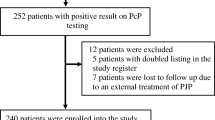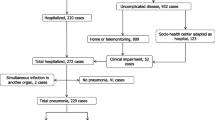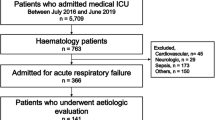Summary
Pneumocystis carinii pneumonia (PCP) in HIV-infected patients remains a life-threatening complication in the course of HIV infection. Despite effective treatment, mortality may still be as high as 10%. The identification of risk factors associated with a lethal outcome might be helpful as a guide to therapy for patients at risk and in the evaluation of new drugs with anti-pneumocystic activity. In a retrospective study 58 first episodes of HIV-associated PCP without prophylaxis were analyzed. Variables associatred univariately with higher mortality were identified. A prognostic rule was established in a multivariate approach using canonical discriminant analysis. Cut-off values for parameters included were determined in order to allow a clinically applicable estimate of the individual risk. Variables associated with early mortality were hemoglobin, hematocrit, platelet count, albumin, total protein, γ-globulins, and AaDO2. LDH values, percentage of neutrophils in the BAL, as well as the cellular immunologic state as indicated by CD4-cell count were not significantly associated with the outcome. The discriminant function yielded the best classification results with the inclusion of hemoglobin, albumin, and γ-globulins (overall accuracy 86%). Two or more of the following parameters were associated with a 14-fold increased risk of in-hospital mortality: hemoglobin less than 10 g/dl, albumin less than 3 g/dl, and γ-globulins less than 1.2 g/dl. This prognostic rule was 80% sensitive and 94% specific with a negative predictive value of 94%, yielding an overall accuracy of 91%. Patients with HIV-associated PCP with a positive prognostic rule have a 14-fold increased risk for in-hospital lethal outcome. This discriminant rule may be helpful in identifying patients at risk.
Zusammenfassung
DiePneumocystis carinii-Pneumonie (PCP) gehört unverändert zu den potentiell lebensbedrohlichen Komplikationen der HIV-Erkrankung. Trotz wirksamer antimikrobieller Therapie ist sie mit einer Letalität von bis zu 10% verbunden. Die Identifikation von Risikofaktoren für einen tödlichen Ausgang könnte Kriterien für therapeutische Eskalationen begründen und sich in der Ermittlung neuer Pneumocystis-wirksamer Medikamente nützlich erweisen. In einer retrospektiven Studie wurden 58 Erstepisoden einer HIV-assoziierten PCP ohne Prophylaxe analysiert. Im univariaten Ansatz wurden Parameter identifiziert, die signifikant mit einem letalen Ausgang assoziiert waren. Anschließend wurde multivariat mittels der kanonischen Diskriminantenanalyse eine prognostische Regel aufgestellt. Um eine klinisch relevante individuelle Risikoabschätzung zu ermöglichen, wurden Schwellenwerte für eingeschlossene Parameter bestimmt. Univariat waren die mittleren Werte des Hämoglobins, Hämatokrits, Thrombozyten, Albumins, Gesamteiweißes, der γ-Globuline und der AaDO2 signifikant mit dem Ausgang der PCP assoziiert. Keine Unterschiede zwischen Überlebenden und Verstorbenen fanden sich für die mittleren Werte der LDH, der Prozentzahl der Neutrophilen in der BAL und der CD4-Zellzahlen. Die Diskriminantenanalyse ergab die besten Klassifikationsergebnisse bei einer Kombination von Hämoglobin, Albumin und γ-Globulinen (Gesamtrichtigkeit der Klassifikation: 86%). Das Vorliegen von mindestens zwei von drei Werten aus Hämoglobin < 10 g/dl, Albumin < 3 g/dl und γ-Globulinen < 1,2 g/dl war mit einem 14fach erhöhten Risiko eines letalen Ausgangs verbunden. Diese prognostische Regel zeigte eine Sensitivität von 80%, eine Spezifität von 94% und einen negativen Vorhersagewert von 94% bei einer Gesamtrichtigkeit von 91%. Patienten mit einer HIV-assoziierten PCP weisen bei Vorliegen von mindestens zwei der drei prognostisch ungünstigen Werte dieser Regel ein 14faches Risiko eines letalen Ausgangs auf. Diese Regel könnte sich somit als hilfreich erweisen, um Risikopatienten zu identifizieren.
Similar content being viewed by others
References
Ewig, S., Rockstroh, J. K., Seitz, H. M., Marklein, G., Christ, F., Lüchters, G., Brockmann, H. H., Lüderitz, B. Pneumocystis carinii-infections in HIV-infected hemophiliacs during aerosolized pentamidine prophylaxis. Respiration 60 (1993) 186–192.
Masur, H. Prevention and treatment ofPneumocystis carinii pneumonia. N. Engl. J. Med. 327 (1993) 1853–1860.
Mallal, S. A., Martinez, O. P., French, M. A. H., James, I. R., Dawkins, R. L. Severity and outcome ofPneumocystis carinii pneumonia (PCP) in patients of known and unknown HIV status. J. Acquir. Immune Defic. Syndr. 7 (1994) 148–153.
Bennett, C. L., Weinstein, R. A., Shapiro, M. F., Kessler, H. A., Dickinson, G. M., Peterson, B., Cohn, S. E., George, L., Gilman, S. C. A rapid pre-admission method for predicting inpatient course of disease for patients with HIV-relatedPneumocystis carinii pneumonia. American Journal of Respiratory and Critical Care Medicine 150 (1994) 1503–1507.
El-Sadr, W., Simberkopf, M. S. Survival and prognostic factors in severePneumocystis carinii pneumonia requiring mechanical ventilation. Am. Rev. Resp. Dis. 137 (1988) 1264–1267.
Speich, R., Weber, R., Kronauer, C. M., Opravil, M., Lüthy, R., Russi, E. W. Prognostic score forPneumocystis carinii pneumonia. Respiration 57 (1990) 259–263.
Garay, S. M., Greene, J. Prognostic indicators in the initial presentation ofPneumocystis carinii pneumonia. Chest 95 (1989) 769–772.
Mathews, W. C., Ferdon, E., Bennett, C. L., Kanouse, D. Evaluating institutional performance in AIDS-associatedPneumocystis carinii pneumonia: a risk-adjustment approach. J. Clin. Epidemiol. 42 (1989) 421–455.
Brenner, M., Ognibene, F. P., Lack, E. E., Simmons, J. I., Suffredini, A. F., Lane, H. C., Fauci, A. S., Parrillo, J. E., Shelhamer, J. H., Masur, H. Prognostic factors and life expectancy of patients with acquired immunodeficiency syndrome andPneumocystis carinii pneumonia. Am. Rev. Respir. Dis. 136 (1987) 1199–1206.
Kales, C. P., Murren, J. R., Torres, R. A., Crocco, J. A. Early predictors of in-hospital mortality forPneumocystis carinii pneumonia in the acquired immunodeficiency syndrome. Arch. Intern. Med. 147 (1987) 1413–1417.
Kagawa, F. T., Kirsch, C. M., Yenokida, G. G., Levine, M. L. Serum lactate dehydrogenase activity in patients with AIDS andPneumocystis carinii pneumonia. An adjunct to diagnosis. Chest 94 (1988) 1031–1033.
Smith, R. L., Ripps, C. S., Lewis, M. L. Elevated lactate dehydrogenase values in patients withPneumocystis carinii pneumonia. Chest 93 (1988) 987–992.
Zaman, M. K., White, D. A. Serum lactate dehydrogenase levels andPneumocystis carinii pneumonia. Diagnostic and prognostic significance. Am. Rev. Respir. Dis. 137 (1988) 796–800.
Mason, G. R., Hashimoto, C. H., Dickman, P. S., Foutty, L. F., Cobb, C. J. Prognostic implications of bronchoalveolar lavage neutrophilia in patients withPneumocystis carinii pneumonia and AIDS. Am. Rev. Respir. Dis. 139 (1989) 1336–1342.
Benson, C. A., Spear, J., Hines, D., Pottage, J. C., Kessler, H. A., Trenholme, G. M. Combined APACHE II score and serum lactate dehydrogenase as predictors of in-hospital mortality caused by first episodePneumocystis carinii pneumonia in patients with acquired immunodeficiency syndrome. Am. Rev. Respir. Dis. 144 (1991) 319–323.
Smith, R. L., el-Sadr, W. M., Lewis, M. L. Correlation of bronchoalveolar lavage cell populations with clinical severity ofPneumocystis carinii pneumonia. Chest 93 (1988) 60–64.
Beck, E. J., French, P. D., Helbert, M. H., Robinson, D. S., Moss, F. M., Harris, J. W. R., Pinching, A. J., Mitchell, D. M. Improved outcome ofPneumocystis carinii pneumonia in AIDS patients: a multifactorial treatment effect. Int. J. STD AIDS 3 (1992) 182–187.
Dawson-Saunders, B., Trapp, R. G. Basic and clinical biostatistics. Appleton & Lange, East Norwalk 1990, pp. 182–190.
Norusis, M. J. To grant or not to grant: discriminant analysis. In: SPSS-X introductory statistics guide for release 3. SPSS Inc., Chicago 1988, pp. 187–196.
Peruzzi, W. T., Skoutelis, A., Shapiro, B.A., Murphy, R. M., Currie, D. L., Cane, R. D., Noskin, G. A., Phair, J. P. Intensive care unit patients with acquired immunodeficiency syndrome andPneumocystis carinii pneumonia: suggested predictors of hospital outcome. Crit. Care Med. 19 (1991) 892–900.
Roth, J. B., Sidman, C. L. Single and combined humoral and cell-mediated immunotherapy ofPneumocystis carinii pneumonia in immunodeficient mice. Infect. Immun. 61/5 (1993) 1641–1649.
Lundgren, B., Lundgren, J. D., Nielsen, T., Mathiesen, L., Nielsen, J. O., Kovacs, J. A. Antibody responses to a majorPneumocystis carinii antigen in human immunodeficiency virus-infected patients with and withoutP. carinii pneumonia. J. Infect. Dis. 165 (1992) 1151–1155.
Burns, S. M., Read, J. A., Yap, P. L., Brettle, R. P. Reduced concentrations of IgG antibodies toPneumocystis carinii in HIV-infected patients during activePneumocystis carinii infection and the possible passive immunisation. J. Infect. 20 (1990) 33–39.
Laursen, A. L., Jensen, B. N., Andersen, P. L. Local antibodies againstPneumocystis carinii in bronchoalveolar lavage fluid. Eur. Respir. J. 7 (1994) 679–685.
Author information
Authors and Affiliations
Rights and permissions
About this article
Cite this article
Bauer, T., Ewig, S., Hasper, E. et al. Predicting in-hospital outcome in HIV-associatedPneumocystis carinii pneumonia. Infection 23, 272–277 (1995). https://doi.org/10.1007/BF01716285
Received:
Accepted:
Issue Date:
DOI: https://doi.org/10.1007/BF01716285




